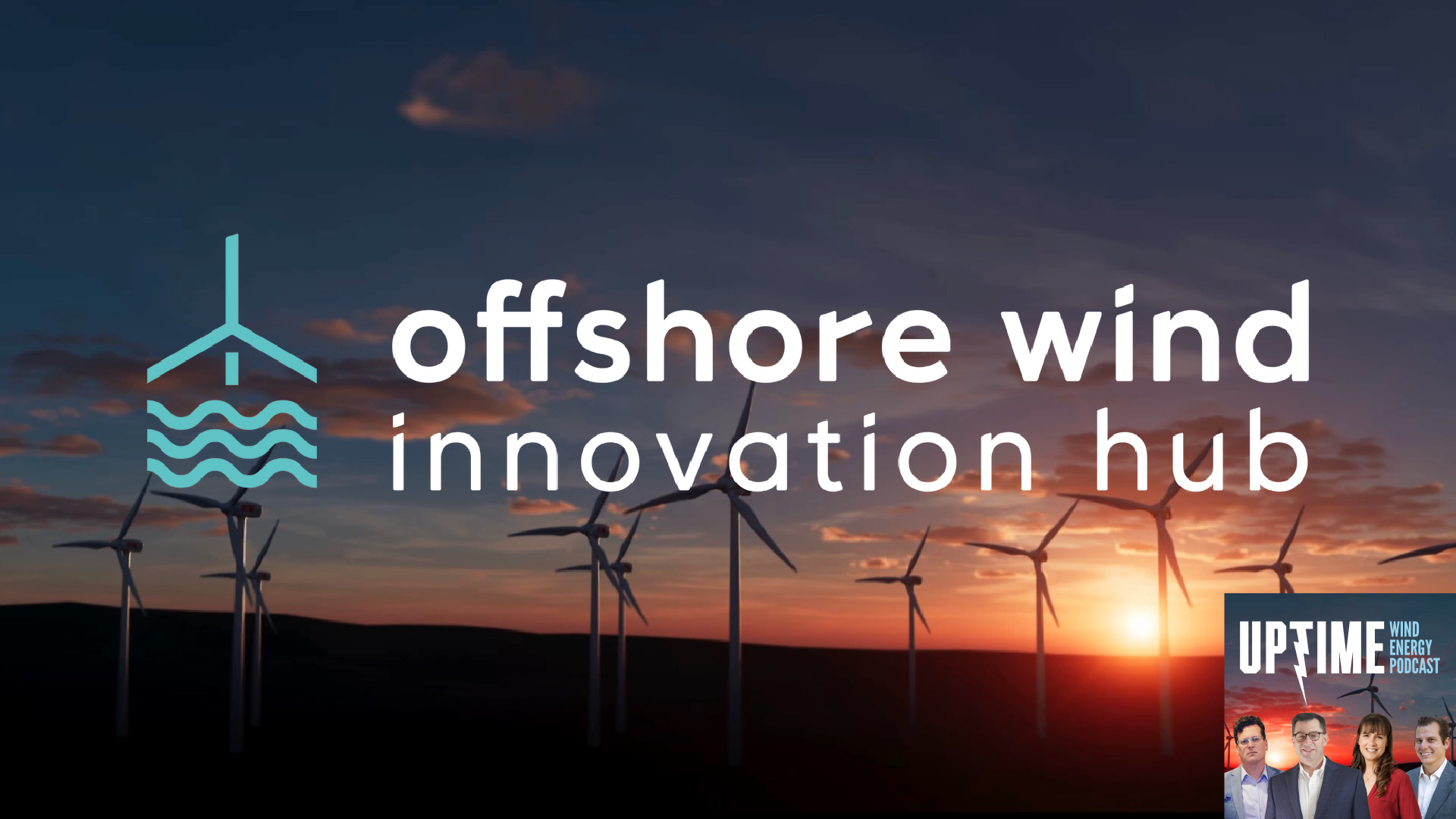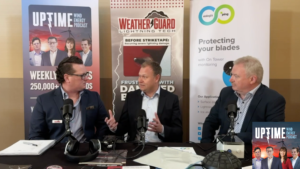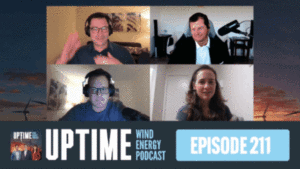Podcast: Play in new window | Download
Allen and Joel interview Tone Søndergaard, Director of the Offshore Wind Innovation Hub. The hub’s six-month accelerator program provides mentorship, industry connections, and resources to help startups scale. Tone shares insights from the first cohort’s outcomes and discusses the global application process for cohort two. If you’re interested in learning more, visit https://www.offshorewindnyc.com/.
Sign up now for Uptime Tech News, our weekly email update on all things wind technology. This episode is sponsored by Weather Guard Lightning Tech. Learn more about Weather Guard’s StrikeTape Wind Turbine LPS retrofit. Follow the show on Facebook, YouTube, Twitter, Linkedin and visit Weather Guard on the web. And subscribe to Rosemary Barnes’ YouTube channel here. Have a question we can answer on the show? Email us!
Pardalote Consulting – https://www.pardaloteconsulting.com
Weather Guard Lightning Tech – www.weatherguardwind.com
Intelstor – https://www.intelstor.com
Allen Hall: Welcome to the special edition of the Uptime Wind Energy Podcast. I’m your host, Alan Hall, along with my co host, Joel Saxam. Starting a new business in the wind industry is particularly difficult. Uh, there are multiple challenges beyond creating a product that the industry needs or wants. Fundraising, staffing, finding an office, technology development, marketing, international sales, the list goes on.
Well, there is help on the way. The Offshore Wind Innovation Hub, located in Brooklyn, New York, is a groundbreaking initiative launched by the NYU Tandon School of Engineering in collaboration with Ecuador, and supported by the New York City Economic Development Corporation. The hub’s mission is to accelerate the growth of the offshore wind industry by supporting startups developing cutting edge technologies, by providing access to mentorship, industry connections, and resources to scale up.
The hub aims to position New York City as a major player in the rapidly growing Offshore wind sector. Leading this ambitious initiative is Tone Sundegaard, uh, the director of the Offshore Wind Innovation Hub. With a background deeply rooted in the Danish wind industry and expensive experience fostering clean tech collaboration between Denmark and the United States, Tone brings a wealth of expertise and passion to her role in shaping the future of offshore wind innovation in New York City and beyond.
Tona, welcome to the program.
Tone Søndergaard: Thank you so much.
Allen Hall: So there is a lot to talk about today, uh, because Hey, we know a lot of small businesses in wind that are trying to get established. We are one of them Uh, and and uh your offshore wind innovation hub Popped up on our radar screen recently, like, Oh, Hey, there’s a lot going on there that we didn’t know about.
And let’s get some, get them on the podcast to talk about all the great activities that are happening there. But I want to first step back and talk about what are some of the problems with starting a small business in wind.
Tone Søndergaard: I think one of the reasons we really started this innovation hub and found that there was a need for an accelerator program and ecosystem development for the smaller businesses within offshore wind was partly twofold in a way.
The first reason really being that we found that smaller businesses, especially within offshore wind, were challenged by what we call information asymmetry, and it was really difficult for many of the smaller businesses who wanted to either move into offshore wind or pivot into offshore wind from other industries to figure out Precisely what is my value proposition?
Precisely when in the supply chain do I fit in? Um, and data in this industry tends to be fairly privileged and sort of like held by some of the really major corporations. Um, so that was really one of the problems that we wanted to try and solve with Innovation Hub was to try and give smaller players access to some of this information and so that they much more efficiently and effectively, um, could enter this industry.
Joel Saxum: Okay, so we’re talking Econor. Econor is Norwegian.
They’re a long ways away. If you’re a United States company, they’re a big, and like, you could look at Econor, it’s like go on LinkedIn. Oh, we have, I don’t know what the number is, but 20, 000 employees or whatever, like, where do I even start? Like, how do I find a stakeholder to even talk to let alone get, you know, to the point where we’re making decisions and making plans and stuff like that.
So it’s a black hole really in some of these large companies when you go into it.
No, completely agree. And I think you were sort of like echoing precisely some of the challenges we also saw with our first cohort, which just ended in December here in 23. Precisely that sort of like wayfinding within some of these like massive energy companies, right, which are setting up shop maybe for the first time in the U.
S. or maybe they have some sort of like oil and gas business already, but it’s completely new structures they’re creating here. Um, and that can be really difficult to wayfind, right? Like what department do I even fit into if I don’t really know what What department does what? You know? So even if we ask sort of like a startup or a relatively new business, like what department in one of the big companies would you like to contact with, they’re like, um, I, I don’t actually know which one does that.
You know?
Yeah. There’s, I mean, there’s, it’s sales 101. You can Google how do I do a sales plan and it will be like stakeholder map and find your personas and stuff. But you’re like. I don’t know. Yeah. Yeah. That concept
Allen Hall: is great. But where do I start? Because I think in wind, uh, it’s a renewable energy.
There’s a lot of focus on it. There’s a lot of tech around it. And I don’t, a lot of smart people are thinking about that industry, getting into that and taking that idea and making it into a product. That’s one phase, right? And I think a lot of the engineers out there that I’ve seen in, in offshore wind and onshore wind have gotten to the, like, Hey, we can make the thing.
Yeah. Absolutely. Absolutely. But, when they get to, now I need to sell it, I need to market it, I need to establish a company, that’s where they have the problem. And a lot of the small companies that Joel and I have been around the last several years that have had great tech, unbelievable tech, have failed because of all the other pieces.
And I, this is where the offshore wind hub comes in, right? So that, uh, can you explain like what things you’re offering to fill those voids that a typical engineer running a company. Misses.
Tone Søndergaard: Absolutely. And I think, you know, in, in startup world or in the accelerator world, we call this kind of like the valley of death or the mountain of opportunity is sometimes it’s also framed as, you know, so that’s a great one, but, um, but you’re precisely right.
What we see a lot of our founders or small businesses coming to us with this, a well functioning product, right? Like it’s a well functioning product. They kind of figured out how to sort of like do the basis of that, but what they are struggling with. And, and one of the things we also focus a lot on for the.
for the Innovation Hub program is to help them with creating that first collaboration with a big energy company, right? Figuring out how do we de risk that collaboration so that they get the information they need to truly figure out what is my value proposition? Because one of the things that we see them come to us with is in order to really scale their business.
What is my business model? How do I price my product? How big of a challenge am I actually solving? And am I sort of like approaching the market with the right type of doing that? So we see a lot of the, the sort of like entrepreneurs that we work with really sort of like need to sort of like scope that out to be able to have a scalable business that, you know, will, will make it great in this industry.
Joel Saxum: You’re helping that entrepreneur, that small company, that, that idea, or sometimes it’s not a small company, sometimes a big company, it’s just a division, something they started. Either way, you’re helping that entity by de risking, understanding, building business models, the international business things we talked about a little bit off air.
Um, but then you’re also say like this, you guys are in partnership with Econor here. However, you’re also building an ecosystem for offshore wind. So it’s not just Econor that you guys have access to, right? But, but you, you’re de risking the technology for them as well. Because when those big companies that have billion dollar assets offshore, And someone comes to them with this new tech, immediately their hair gets up on the back of their neck, like, you know, Should we take this risk on?
Should we trust these people? Is it, because, because, and here’s the, here’s the trouble with offshore. Okay, so again, I’ll, I’ll go back to case study type thing, or examples. Weatherguard Lightning Tech, putting strike tape on. You put strike tape on 10 turbines in Texas, and it costs you X. You go try to put strike tape as a test on 10 turbines offshore, And it costs you X times five or 10 just because of vessel time and downtime, all these different things.
So it’s really hard to test products offshore as well. And for the company that owns those assets or is paying for that time and that effort that they need a de risk for them too. And you can, you know, as a business person, you can understand that.
Tone Søndergaard: You’re so right. Like that what we are kind of experiencing actually is like working closely with an entity like Equinor.
It’s precisely like they get a framework by which they can collaborate with a small business for six months, which is part of our accelerator, if you accept it in, right? You get mentorship, but you also get that collaboration where you can kind of, where both sides can sort of like feel each other out a little bit, right?
And in a, in a setting sort of like test out or figure out what is, what is the road to testing this? Because I think you’re precisely right, what we hear from many of the developers or the big sort of like OEMs is it’s really risky right now, right? Right. All of them are feeling like they’re taking on a lot of risk in a, in a market that’s completely new and where the supply chain feels, you know, not fully established yet.
Um, so I think that’s really sort of like what we also try and tackle with this.
Joel Saxum: Pair up with who your end user will be right away at the early stages in your product so that you’re not building a. solution and looking for a problem. You’re actually found a problem and you have a solution and you’re working toward directly towards it.
Tone Søndergaard: Like an additional part of this and what you also hinting to, right. As we see quite a lot of like technical founders coming into our startup programs, people have amazing ideas, but maybe they need some help with the pitching, right? Like it, It’s a space where you need to be good at selling your product.
And that maybe isn’t necessarily what you learned during your PhD, where you develop something magnificent, right? Like maybe that was not top on the charity list, you know?
Joel Saxum: Yeah, yeah, yeah. Sure, for sure. You did, you, you got a PhD, So you’re, you got, now you’ve got to figure out, Uh, the grassroots way, like by, by paying how to sell things, not to commercialize things, but you get in on board with state offshore wind accelerator program.
Now, all of a sudden you have this whole team around you get, we’re going to help you commercialize this thing. Here’s how we’re going to do it. Here’s the partnerships. It’s, it’s a fantastic initiative. I applaud you guys for doing this.
Allen Hall: So the first cohort has just passed through the program, uh, I think it’d be helpful for everybody listening to understand what the program looks like.
It’s a six month program, how to get selected, what happens once you’re accepted, and what is, and what is that first cohort experienced in their run in that timeframe?
Tone Søndergaard: So we’re actually searching for our cohort two right now. So like shout out to everyone out there who maybe had a great idea. Sitting there being, uh, an innovator or, uh, being at this stage where we’re looking to engage.
We often sort of like take in companies who are sort of in that early revenue phase or maybe more established in another industry and then pivoting into offshore wind. Um, and the program essentially is so that you apply, you have to do that by like end of March essentially. Then sort of like this fairly vigorous down selection process starts, we have, uh, I think 20 plus technical evaluators who looks at the different technologies, figuring out is this, you know, something that is actually solving a problem that the developers have, uh, both specifically for Equinor, but we also have the National Offshore Wind Research and Development Council, helping us sort of have that national outlook on things, um, and then halfway through the selection process, we invite the 12 finalists, To come to New York, pitch at a public pitch event, but also interview with us and all of the partners behind the program to really sort of like scope out.
How is your fit within this program? Are we the right ones to help you? Because I think it’s important to say that we are a non dilutive accelerator. We don’t take equity. Um, so we have, you know, one pure goal and that’s finding the startups who we can help the most, um, throughout the six months. which you’re hinting to, right, if selected to be part of the sex, which is, happens in June, then this six months intensive process, uh, with my fantastic team, um, and all of the partner organizations who also all sort of like contribute to the programming, um, includes, uh, three trips to New York, coming here for a week at a time, workshop more than, you 25 different like expert sessions, but also a lot of what we call peer to peer work.
Um, we really utilize that the different founders or executives entering the program have different types of learnings that they can share with one another and grow their understanding in that sense. Um, but then they’re also paired with an Equinor mentor who can really sort of like dive into the technical challenges they might be facing.
Um, and then of course we try and really help them build their business by just overloading with, with their contacts within, within the offshore wind industry, right? Um, all with the aim to answer the last part of your question, what are the outcomes? I think. More or less all of our companies from cohort one now have revenue streams in New York, so they actually managed to sort of like do that.
We are seeing a hopefully great fundraising news coming out from some of them very soon. Um, many of them looking to establish shop in New York, like actual manufacturing facilities coming to New York because of this program. Um. Yeah, that, which is a fantastic outcome, um, and yeah, their first hires, you know, that’s also what we do a lot, helping them find hires.
Some of, we utilize NYU’s intern programs to get them great, sort of like talented, but we also help them hire more sort of like a C level or mid level people, which is what many of them maybe need in New York. So tons of different types of outcomes in that sense, but all really exciting. And we’re so proud of our first cohort.
Allen Hall: Applicants to your program are not limited to New York or New York City. It’s a global open calling for tech companies to apply, right? I think your first cohort had a number of non U. S. companies apply. You want to describe who you’re looking for?
Tone Søndergaard: We are looking for the most promising, both hardware and software, from all over the globe.
In our first cohort, we had half European companies, half American companies joining our cohort. Hopefully this year we’ll have even more great startups also from either the South American continent or from Asia, where we’re seeing great applicants coming in from. You know, they’re really starting to catch on to offshore wind as well.
So that’s super exciting. And what we’re really looking for is precisely like technologies that can help American developers lower the cost of developing these projects. So one of the key things we’re looking for. Is a technology’s innate, like, ability to facilitate that kind of like either cost reduction or efficiency gains or whatever your sort of like technology works on.
Allen Hall: That applies to hardware companies and software companies, right? It’s both.
Joel Saxum: Absolutely. If you’re in wind, you know that a lot of technology that’s used in the States comes from Europe, right? Comes from Northern Europe, comes from the Danes, comes from people over there. So that’s a, that is a non trivial thing to navigate because people don’t, a lot of people don’t realize it.
It doesn’t matter where you are in the globe, that’s a tough way to do business if you don’t understand it. So getting these people in one room together to share experiences, to share business knowledge, engineering knowledge, whatever that may be, that’s a huge advantage of this program.
Tone Søndergaard: And I think you’re precisely right.
What we see that especially the different founders or executives can learn from one another. It’s actually that like business culture part of it. I think so. Like technology wise, many of them again have figured that out. And that’s maybe more similar. But how you sell a product is really different between even the same people.
Like maybe European headquartered developers, how they operate in Europe and how they operate in the States is completely different. Um, and many of them are kind of like struggling with that being like, if I’m European, cold calling might not be such as a like way of going about things, right? And like, how, how much humor should I use in my first couple of meetings?
You know, it’s like,
Joel Saxum: Sure, for sure.
Tone Søndergaard: Stuff like this and like, scoping out like, what is the, what is the culture I’m going for here? Like, how insistent can I be? How, one of the questions we really encounter often is like, when do I start talking about the price of my product? Like, when is that appropriate, right?
And that differs, um, between the U. S. and Europe in many ways. So we really try and focus on, on them learning some of that from one another, because that’s often more effective than, you know, sort of like a set of experts coming in and telling you how to run your business that rarely works as well, you know?
Joel Saxum: Experiential on the same plane, right? To be honest with you, the way you sell things, even within the United States, is different. You sell something different to someone from the northern Midwest, then you do Texas, then you do California, then you do Massachusetts. So even just here, you got to understand those, those kind of, um, ends and outs, I
Allen Hall: would say.
This is a great program. And I know that’s a little bit of a short timeframe to get into cohort two. How do people connect with the hub? How do they apply to the hub? And what does that process, that application process look like?
Tone Søndergaard: Everyone interested in reading our full call for innovators should go to offshorewindnyc.com
That’s kind of easy. Um, there we have sort of like laid out the full, full material. That’s also where the app, online application portal is. And it’s, uh, I would say it takes, depending on how many application one has behind them, like it maybe takes three, four or five hours to fill out the application.
So it’s a little bit of a time commitment, but we really try to make it, you know, as intuitive and as straightforward as possible. Um, So that’s kind of like the really easy way of doing it. If you have questions and we really encourage all our potential applicants to reach out to us first, we happy to help sort of like maybe frame the, the application you have in mind a little bit.
Talk through some of the points where you’re a little bit in doubt about should I be specific here or be more broad? How do I make the strongest case for precisely my solution? Then you can reach out to me or my team. And we take 30 minute calls with everyone who’s interested in applying. And that can also be facilitated through the website.
Allen Hall: And there’s no application fee. It’s totally free. It’s all online and you can apply from anywhere.
Tone Søndergaard: You can apply from anywhere. No application fee. Even if you join the cohort, there is, again, there’s no fee of joining. Everything is free for the, for the cohort selected and, um, and we provide travel grants.
So if you, if you come from far away, we’ll help you sort of like make it possible coming to New York.
Allen Hall: Right. That’s an important note because if you do come from Europe or South America or even Japan, even South Korea, big wind in places. Or Austin, Texas. Austin, Texas, which is a long ways away, right? It’s not free to travel and travel is expensive today.
So it really. It’s a smart move because you want to get the innovation out into service as quickly as you can. You need to accelerate it and you are. And that’s why this program is so innovative. I like that Equinor stepped into the space. I like, Tona, what you’re doing and the efforts you’re making. I, The first cohort is really interesting if you can go online, I encourage everybody to go online and look at the list of the first cohort and where they’re going, that’s a fascinating list.
Tona, I really appreciate you being on the program, we’re going to blast this out to everybody, so if you’re interested and you have a tech company and you’re trying to grow an offshore wind, you need to get a hold of Tona. And you need to get a hold of her fast and you need to be applying for this program, so Tona, thank you so much for being on the podcast, we love having you.
Tone Søndergaard: Thank you so much, it was a pleasure being with you today.











